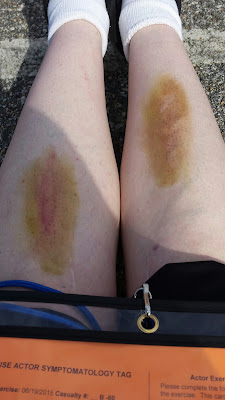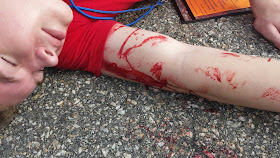IN THIS ARTICLE: None of the photos depict anything real; this is all MOCKed up.
There. Right there. That's where the imaginary bomb went off. And then all hell broke loose.
For a long time, it was just us victims lying on the ground, confused and "injured."
Injuries were sorted beforehand.
I had bilateral leg breaks, so I was non-ambulatory, but not in a life threatening situation. That's moulage on my legs - they made us up so the first-responders were better able to interpret this situation as real. You'll also see on my task sheet that I was a sixteen-year-old male and somehow also alert and following directions. I don't remember ever meeting a sixteen-year-old who was both alert and following instructions. Mostly, I get eyerolls and mumbles that sound like "no way, dude" from my sixteen-year-olds.

Let me tell you a story here about communicating in an emergency. First, I texted. You should text in an emergency so the cell towers aren't overburdened. So, good on me.
This is what I texted though:
Kid #3 has a broken ankle and head trauma. I have two broken legs.
I attached the above picture of my startlingly white legs and these photos of kid #3.
Hubby knew that #3 and I were volunteering in a mock event. He knew we'd be moulaged. He wondered what injuries they would give us. That's why I sent him the quick text. Sigh.
Hubby did not remember any of that in the middle of his national sales meeting where he received my quick text and three photos. My husband, bless him, was terrified that he was on the wrong coast when we needed him. He had a full blown adrenaline rush and horror/fear for us. I learned that we should never assume and be very very very clear in our real life communications.
In your book? The more confusion the better.
Things I learned:
- It will be a very long time before responders get themselves organized and treating people. They have to get the call and get themselves on scene. There's a hierarchy that is put in place. Organizing that has to happen. Practiced and quick, for sure, but seconds count.
- They can't send the responders in until it is deemed safe. This makes sense. If the responders are hurt, then who is there to help? The responders had to sit outside of the perimeter and wait for the bomb dogs to come and check out the area before an all-clear was called. (for some people, that was a lot of bleeding time.)
- Your character had better have some first-aid skills in their personal mental toolkit, and some supplies in their purse.
- When it's ninety degrees outside, your character will cook if you lay on the road until help gets you moved. Serious skin burns. I'm not kidding. Please remember that when you lay someone on the ground in heat or cold in your writing - save them some extra agony. Or don't. Who am I to make it easier on your characters?
- If you are ambulatory, get your character up and ambulate. Seriously. No. One. Is. Coming. They're last on the list, and they confuse the workers trying to get to those with life or death injuries. Just need to prove that character is a prima donna? Fine, leave her out their crying over her scraped knee while someone is looking for the bottom half of their leg. Character development at its clearest.
- If your characters are non-ambulatory, the responders will put them to work if they're conscious. I, for example, was next to a kid with an amputated thumb. I did my best to help him until they set up the triage tents (green, yellow, and red - indicating who gets treatment first). Then I sent him on his way. His feet worked, no need to fry him on the macadam.
(That's a rubber thumb, and some blood gel and he tucked his real thumb and screamed bloody murder.)
- There will not be enough first aid supplies.
- There will be an insane amount of chaos; it's noisy and confusing, smoke, debris, people's belongings scattered as they escape. . .
- People who are in bombing events have the same issues they had before the bombing event. So heart patients have heart issues. Diabetics can have low blood sugar. People with mental health issues still have mental health issues. These things increase the problems.
- The first responders are human. They get hot. They get tired. They get overwhelmed. They get frustrated.
- The hospitals divide the patients based on capacity and expertise. They may send Hubby to trauma hospital C because they can take 4 more traumas there. They may send Wifey to hospital B because they have two extra orthopedic surgeons on hand. They may send Kid #3 to the pediatric hospital because they have expertise in adolescent head trauma. Now the family has to find each of their missing members and go from hospital to hospital to talk to doctors and give support.
I hope this has given you some new insights for the mass casualty event your writing. I have other such articles available with more information about how responders respond and what it felt like to be on the receiving end of their care. Look at the top of this blog for the Out and About tab or go HERE
As always, a big thank you ThrillWriters and readers for stopping by. Thank you, too, for your support. When you buy my books, you make it possible for me to continue to bring you helpful articles and keep ThrillWriting free and accessible to all.







This brings me back to a scene in one of my books when I had to describe (and interview people) a scene after a drunk driver side-swiped a truck load of teens and hit another car head-on. Bodies were scattered all over the highway. When I interviewed the first responders, I got first-hand information on just how chaotic everything was--even getting enough ambulances was crazy. The drunk driver ended up in the same ambulance with one of the injured who was losing blood and consequently not irrational. There was a moment of total panic in the EMT's life when he became the brunt of a possible assault. Then when they got to the hospital, the staff had to call in all kinds of help. It wasn't your normal scene. I hope I'm never in the middle of a terrorist attack or have to witness anything of this magnitude. I have gobs of respect for first-responders and EMT staff.
ReplyDelete